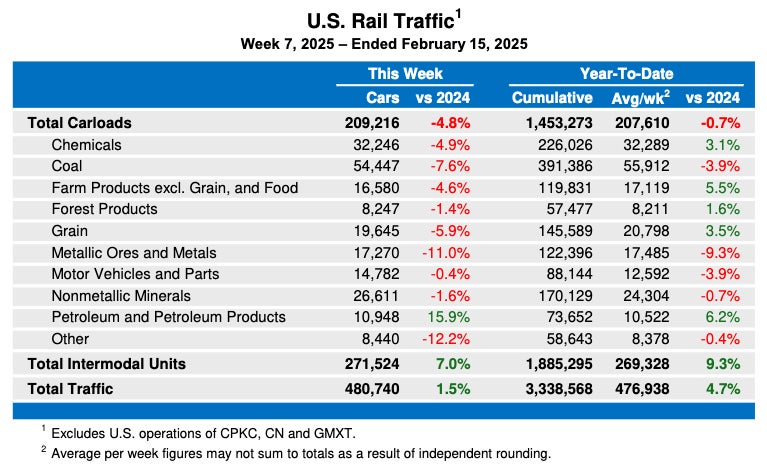The Association of American Railroads (AAR) on Thursday reported total U.S. rail traffic for the week ending Feb. 15 of 480,740 carloads and intermodal units, up 1.5% compared with the same week in 2024.
A total 209,216 carloads was down 4.8% y/y, while intermodal volume of 271,524 containers and trailers was up 7%.
Just one of the 10 carload commodity groups, petroleum and petroleum products, posted an increase compared with the year-ago week, up 1,501 carloads, to 10,948. Commodity groups that posted decreases compared with the same week in 2024 included coal, down 4,472 carloads, to 54,447; metallic ores and metals, down 2,130 carloads, to 17,270; and chemicals, down 1,655 carloads, to 32,246.
For the first seven weeks of 2025, U.S. railroads reported cumulative volume of 1,453,273 carloads, off 0.7%, and 1,885,295 intermodal units, up 9.3% y/y. Total combined U.S. traffic for the first seven weeks of 2025 was 3,338,568 carloads and intermodal units, an increase of 4.7%.

North American rail volume for the week on nine reporting U.S., Canadian and Mexican railroads totaled 311,694 carloads, down 5.9%, and 349,663 intermodal units, up 3.5% y/y. Total combined traffic was 661,357 carloads and intermodal units, down 1.2%.
North American rail volume for the first seven weeks of 2025 was 4,584,752 carloads and intermodal units, up 3.6% compared with 2024.
Canadian railroads reported 87,034 carloads for the week, down 6.3%, and 65,628 intermodal units, down 7.1% y/y. For the first seven weeks of 2025, Canadian railroads reported cumulative volume of 1,091,660 carloads, containers and trailers, up 2%.
Mexican railroads reported 15,444 carloads for the week, down 17.3% compared with the same week a year ago, and 12,511 intermodal units, down 7.1%. Cumulative volume on Mexican railroads for the first seven weeks of 2025 was 154,524 carloads, containers and trailers, down 8.5% y/y.
Subscribe to FreightWaves’ Rail e-newsletter and get the latest insights on rail freight right in your inbox.
Related coverage:
New Orleans Public Belt Railroad expands liquid bulk capacity
